|
|
Creator | Title | Description | Subject | Date |
| 1 |
 |
Kestle, John R. W. | Abdominal binders | Sklar and colleagues2 describe their experience managing "over-shunting headaches" with an abdominal binder. Seventy children with over-shunting headaches complied with application of a binder for about 1 month. In 61 patients (87%), the headaches "greatly improved or went away." This headache relie... | | 2012-01-01 |
| 2 |
 |
Kestle, John R. W.; Walker, Marion L. | Adjustment and malfunction of a programmable valve after exposure to toy magnets | Inadvertent adjustments and malfunctions of programmable valves have been reported in cases in which patients have encountered powerful electromagnetic fields such as those involved in magnetic resonance imaging, but the effects of small magnetic fields are not well known. The authors present a ca... | | 2004 |
| 3 |
 |
Dailey, Andrew T. | Agreement between orthopedic surgeons and neurosurgeons regarding a new algorithm for the treatment of thoracolumbar injuries: a multicenter reliability study | Introduction: Considerable variability exists in the management of thoracolumbar (TL) spine injuries. Although there are many influences, one significant factor may be the treating surgeon's specialty and training (ie, orthopedic surgery vs. neurosurgery). Our objective was to assess the agreement ... | Thoracolumbar injuries; Rating; Classification; TLISS; Neurosurgery; Interspeciality reliability | 2006 |
| 4 |
 |
Dailey, Andrew T.; Brodke, Darrel S.; Bachus, Kent N. | Anterior cervical fixation: analysis of load-sharing and stability with use of static and dynamic plates | Background: Anterior plates provide stability following decompression and fusion of the cervical spine. Various plate designs have emerged, and they include static plates with fixed-angle screws, rotationally dynamic plates that allow the screws to toggle in the plate, and translationally dynamic pl... | Anterior cervical fixation; Load-sharing; Stability; Static plates; Dynamic plates | 2006 |
| 5 |
 |
Dailey, Andrew T.; Schmidt, Meic H.; Apfelbaum, Ronald I. | Anterior fixation of odontoid fractures in an elderly population | Object. Fractures of the odontoid process are the most common fractures of the cervical spine in patients over the age of 70 years. The incidence of fracture nonunion in this population has been estimated to be 20-fold greater than that in patients under the age of 50 years if surgical stabilizatio... | Odontoid fractures; Elderly population; Anterior fixation | 2010 |
| 6 |
 |
Kestle, John R. W. | Assessing the validity of the endoscopic shunt insertion trial: did surgical experience affect the results? | Object. Most surgical procedures are associated with a learning curve in which the success rate is lower early in the experience before mistakes have been identified and modifications made to the procedure. Negative results obtained early in a trial's learning curve may be a matter of timing rather ... | Endoscopic shunt insertion; Ventriculoperitoneal shunt; Pediatric neurosurgery; Surgical experience | 2004-01-01 |
| 7 |
 |
Couldwell, William T. | Assessment of long-term remission of acromegaly following surgery | Object. The criteria for remission of acromegaly following transsphenoidal adenoma resection are in evolution. In the present study the authors evaluate the utility of predicting long-term remission by reference to a single fasting growth hormone (GH) level on the 1st postoperative day. Methods. A ... | Acromegaly; Pituitary adenoma; Transsphenoidal surgery; Growth hormone; Insulin-like growth factor I | 2003-01-01 |
| 8 |
 |
Schmidt, Meic H. | Assessment of the reliability of the Enneking and Weinstein-Boriani-Biagini classifications for staging of primary spinal tumors by the spine oncology study group | Despite advances in the treatment of primary spinal tumors in recent years, the with respect to the feasibility of oncologically appropriate surgical treatment and the selection of the optimal surgical approach. These tumors are relatively rare, comprising 11% of all primary musculoskeletal tumors a... | | 2009-01-01 |
| 9 |
 |
Couldwell, William T. | Astrocytoma cell line | TO THE EDITOR: It has long been established clinically that patients with neurofibromatosis Type 1 (NF1) have an increased susceptibility to develop many central and peripheral tumors. The nature of the genetic alterations underlying NF1 have recently begun to be characterized. It has been demo... | | 2001 |
| 10 |
 |
Schmidt, Meic H.; Apfelbaum, Ronald I. | Atlantoaxial transarticular screw fixation: a review of surgical indications, fusion rate, complications, and lessons learned in 191 adult patients | Object. In this, the first of two articles regarding C1-2 transarticular screw fixation, the authors assessed the rate of fusion, surgery-related complications, and lessons learned after C1-2 transarticular screw fixation in an adult patient series. Methods. The authors retrospectively reviewed 191 ... | Atlantoaxial junction; Craniocervical junction; Instability; Transarticular screw fixation; Fusion | 2005 |
| 11 |
 |
Schmidt, Meic H. | Benzoporphyrin derivative and light-emitting diode for use in photodynamic therapy: applications of space light-emitting diode technology | Photodynamic therapy (PDT) is a cancer treatment modality that recently has been applied as adjuvant therapy for rain tumors. PDT consists of intravenously injecting a photosensitizer, which preferentially accumulates in tumor ells, into a patient and then activating the photosensitizer with a light... | Benzoporphyrin; Photodynamic therapy; Brain tumors; Photofrin | 1998 |
| 12 |
 |
Couldwell, William T.; Orlandi, Richard R. | Carotid artery-sparing repair of a cavernous carotid artery pseudoaneurysm | Carotid artery (CA) injury after transsphenoidal and endoscopic sinus surgery is a well-recognized but fortunately rare complication.1 It is associated with significant morbidity and mortality rates5 and is more common in cases of repeated surgery, cavernous sinus invasion, prior radiotherapy, and ... | Carotid artery; Sinus; Pseudoaneurysm; Endoscopic surgery | 2006 |
| 13 |
 |
Schmidt, Meic H. | Castleman disease of the spine mimicking a nerve sheath tumor | Castleman disease is a rare lymphoproliferative disease of unknown cause. In most cases, afflicted patients present with a mediastinal mass although the disease may manifest in numerous other sites, including intracranially and rarely intraspinally. The authors report on the case of a 19-year-old wo... | Castleman disease; Nerve sheath tumor | 2007 |
| 14 |
 |
Gluf, Wayne M.; Gottfried, Oren N.; Schmidt, Meic H. | Cavernous hemangioma of the skull presenting with subdural hematoma | Cavernous hemangioma of the calvarium is a very rare disease, and patients usually present with headaches or a visible skull deformity. Few reports of patients presenting with intradiploic or epidural hemorrhages are found in the literature. No cases of an intradural hemorrhage from a cavernous hema... | Hemangioma, Cavernous; Skull; Hematoma, Subdural | 2004-07-15 |
| 15 |
 |
Schmidt, Meic H. | Cavernous hemangioma of the skull presenting with subdural hematoma | Cavernous hemangioma of the calvaria is a very rare disease, and patients usually present with headaches or a visible skull deformity. Few reports of patients presenting with intradiploic or epidural hemorrhages are found in the literature. No case of an intradural hemorrhage from a cavernous hemang... | Calvaria; Cavernous hemangioma | 2004 |
| 16 |
 |
Couldwell, William T.; Jensen, Randy L.; Gillespie, David L. | Celecoxib inhibits meningioma tumor growth in a mouse xenograft model | Background: Treatments for recurrent meningiomas are limited. We previously demonstrated universal expression of COX-2 in meningiomas and dose-dependent growth inhibition in vitro with celecoxib, a COX-2 inhibitor. We therefore tested the effects of celecoxib on meningioma growth in a mouse xenograf... | Meningioma; Cyclooxygenase-2; COX-2; Celecoxib | 2007 |
| 17 |
 |
Jaeckle, Kurt A.; Digre, Kathleen B.; Jones, Christopher R.; Bailey, Peter L. | Central neurogenic hyperventilation: pharmacologic intervention with morphine sulfate and correlative analysis of respiratory, sleep, and ocular motor dysfunction. | Central neurogenic hyperventilation (CNH), for which there is no effective therapy, can eventually result in respiratory fatigue and death. This report describes a patient with CNH due to a brainstem anaplastic astrocytoma who also exhibited disturbances of sleep and ocular motor function. The CNH r... | Central Neurogenic H yperventilation; Ocular Motor Dysfunction | 1990-11 |
| 18 |
 |
Kestle, John R. W. | Cerebrospinal fluid shunt technology | Since the invention of the first implantable shunt valve by Nulsen and Spitz (12) almost 50 years ago, there has been a remarkable number of ingenious modifications and new designs of shunt equipment to treat pediatric hydrocephalus. These developments were in response to the immediately evident hi... | Shunt technology; Valve design | 2000 |
| 19 |
 |
Dailey, Andrew T.; Brodke, Darrel S. | Cervical end of an occipitocervical fusion: a biomechanical evaluation of 3 constructs | Object. Stabilization with rigid screw/rod fixation is the treatment of choice for craniocervical disorders requiring operative stabilization. The authors compare the relative immediate stiffness for occipital plate fixation in concordance with transarticular screw fixation (TASF), C-1 lateral mass... | Harms technique; Occipitocervical fusion; Transarticular screw; Translaminar screw; Craniocervical instability | 2008 |
| 20 |
 |
Schmidt, Meic H.; Apfelbaum, Ronald I. | Cervical spinal metastasis: anterior reconstruction and stabilization techniques after tumor resection | Object. In a review of the literature, the authors provide an overview of various techniques that have evolved for reconstruction and stabilization after resection for metastatic disease in the subaxial cervical spine. Methods. Reconstruction and stabilization of the cervical spine after vertebral... | Cervical spine reconstruction; Metastasis; Spine tumor; Corpectomy; Stabilization technique; Vertebral body | 2003 |
| 21 |
 |
Schmidt, Meic H. | Cervical spine deformity associated with resection of spinal cord tumors | Postoperative sagittal-plane cervical spine deformities are a concern when laminectomy is performed for tumor resection in the spinal cord. These deformities appear to occur more commonly after resection of intramedullary spinal cord lesions, compared with laminectomy for stenosis caused by degener... | Kyphosis; Cervical deformity; Intramedullary tumor; Laminectomy; Children | 2006 |
| 22 |
 |
Schmidt, Meic H. | Cervical spine metastases: techniques for anterior reconstruction and stabilization | The surgical management of cervical spine metastases continues to evolve and improve. The authors provide an overview of the various techniques for anterior reconstruction and stabilization of the subaxial cervical spine after corpectomy for spinal metastases. Vertebral body reconstruction can be ac... | | 2012-01-01 |
| 23 |
 |
Kestle, John R. W. | Change in ventricular size and effect of ventricular catheter placement in pediatric patients with shunted hydrocephalus | OBJECTIVE: The multicenter, randomized pediatric cerebrospinal fluid shunt valve design trial found no difference in the rate of shunt failure between a standard valve, a siphon-reducing valve (Delta; Medtronic PS Medical, Goleta, CA), and a flow-limiting valve (Orbis Sigma; Cordis, Miami, FL); ho... | Shunt failure; Valve design; Ventricular size; Ventricular catheter placement | 1999 |
| 24 |
 |
Couldwell, William T. | Cholesteatoma of the clivus case report | Objective: Cholesteatomas (CNS epidermoids) can be found intradurally or extradurally in the central nervous system. Extradural intraosseous lesions are most commonly found in the petrous bone. Design: Case report Clinical Presentation: The authors describe a unique case of a clival cholesteatoma o... | | 2006-01-01 |
| 25 |
 |
Couldwell, William T. | Choroid plexus cyst development and growth following ventricular shunting | Choroid plexus cysts are typically incidental, asymptomatic cysts. They have been reported to hemorrhage and grow, causing symptoms of obstruction. However, growth and multiplication has not been reported following ventriculoperitoneal shunting procedures. A 66-year-old woman initially underwent a ... | Choroid plexus cyst; Ventriculoperitoneal shunt | 2008-01 |
| 26 |
 |
Schmidt, Meic H.; Apfelbaum, Ronald I. | Chylorrhea: a rare complication of thoracoscopic discectomy of the thoracolumbar junction | The thoracic duct along with the cisterna chyli is a major lymphatic pathway near the anterior thoracolumbar spine. Despite the fragile nature of the lymphatic system and its proximity to the spinal column, chylorrhea is rarely encountered by spine surgeons. The authors present a unique case of chyl... | Chylous leak; Thoracoscopy; Thoracic spine; Thoracoscopic discectomy; Thoracolumbar junction; Chylorrhea | 2007 |
| 27 |
 |
Couldwell, William T. | Clinical and radiographic response in a minority of patients with recurrent malignant gliomas treated with high-dose tamoxifen | PREVIOUS WORK HAS demonstrated the importance of the Protein Kinase C (PKC) signal transduction system in regulating the growth rate of malignant gliomas in vitro. Tamoxifen inhibits PKC in a minority of malignant gliomas within the micromolar concentration range in vitro, a property distinct from... | Tamoxifen; Protein kinase C; Glioma; Brain neoplasm; Chemotherapy; Glioma | 1993 |
| 28 |
 |
Couldwell, William T. | Combined transmastoid retro- and infralabyrinthine transjugular transcondylar transtubercular high cervical approach for resection of glomus jugulare tumors | COMPLEX TUMORS OF the glomus jugulare present a surgical challenge because of their difficult location, extreme vascularity, and involvement with multiple cranial nerves. Modern microneurosurgical and cranial base techniques have enabled safe total removal of these complicated tumors. We describe a ... | Cranial base approach; Surgical approach; Glomus jugulare tumor; Jugular foramen exposure; Microsurgical anatomy | 2006 |
| 29 |
 |
Couldwell, William T. | Comment on Aydin, K., et al: Localization of cerebrospinal fliud leaks by gadolinium-enhanced magnetic resonance cisternography: a 5-year single-center experience | The Author's describe the use of intrathecal Gd-enhanced MR cisternography for the definition of cerebrospinal fluid leaks in 51 patients. They were able to identify the site of leak in 43 of 51 patients (84%). Although the technique is not new, most of the previous articles are found in the neuror... | Cerebrospinal fluid leaks | 2007 |
| 30 |
 |
Couldwell, William T. | Comment on Kitano, M. and Taneda, M.: Extended transsphenoidal approach to the anterior communicating artery aneurysm: aneurysm incidentally identified during macroadenoma resection | Kitano and Taneda describe the successful clipping of an ACoA aneurysm via the transsphenoidal approach. There are limitations of the approach; most notable are the limited and narrow corridor and the relationship between the aneurysm and the optic chiasm, which may hinder full visualization of the ... | Aneurysm; Transsphenoidal approach | 2007 |
| 31 |
 |
Couldwell, William T. | Comment on Kitano, M., et al.: Subdural patch graft technique for watertight closure of large dural defects in extended transsphenoidal surgery | Ahn and Kim demonstrate a suturing technique to close dural defects after transsphenoidal and extended transsphenoidal approaches. The technique entails a specifically designed forceps to cinch the knot down in the depths of the field. The Author's used the technique in 21 consecutive patients (16 e... | Transsphenoidal surgery; CSF leaks | 2009 |
| 32 |
 |
Couldwell, William T. | Comment on Nugent, G. R.: Targeting the ventral lateral nucleus of the thalamus: a stereotactic vignette | Dr. Nugent provides a fascinating personal account of his early experience with stereotactic surgery for movement disorders. I was especially pleased to read the positive comments regarding the personal interactions with and innovations of Irving Cooper, a neurosurgeon who was derided by his peers b... | Stereotactic surgery; Stereotaxis | 2006 |
| 33 |
 |
Couldwell, William T. | Comment on Wong, H. T., et al.: Comparative impact of video consultation on emergency neurosurgical referrals | The Author's explored the facility and accuracy of telephone, teleradiology, or video consultation between a large general hospital and their tertiary neurosurgical center. Although there was increased diagnostic accuracy with video consultation or teleradiology, they note that consultation via vid... | Teleradiology; Video consultation; Neurosurgical referrals | 2006 |
| 34 |
 |
Couldwell, William T. | Comment on: Chronic brain inflammation and persistent herpes simplex virus 1 thymidine kinase expression in survivors of syngeneic glioma treated by adenovirus-mediated gene therapy: implications for clinical trials | The long-term consequences of adenovirus-mediated conditional cytotoxic gene therapy for gliomas remain uncharacterized. We report here detection of active brain inflammation 3 months after successful inhibition of syngeneic glioma growth. The inflammatory infiltrate consisted of activated macrophag... | Brain inflammation; Herpes simplex virus-1; Thymidine kinase; Syngeneic glioma; Adenovirus-mediated gene therapy | 1994 |
| 35 |
 |
Couldwell, William T. | Communication between malignant glioma cells and vascular endothelial cells through gap junctions | Object. Extensive invasion and angiogenesis are hallmark features of malignant gliomas. Communication between malignant glioma cells and surrounding astrocytes occurs, resulting in transformation of the astrocytic phenotype. In the present study, the authors examined whether malignant glioma cells a... | | 2003-01-01 |
| 36 |
 |
Kestle, John R. W. | Comparison between magnetic resonance imaging and computed tomography for stereotactic coordinate determination | The spatial accuracy of magnetic resonance imaging (MRI) has not been established for stereotactic surgery. Magnetic susceptibility artifacts may lead to anatomical distortion and inaccurate stereotactic MRI coordinates, especially when targets are in regions of the brain out of the center of the ma... | Computed tomography; Stereotactic coordinates; Stereotactic surgery | 1992 |
| 37 |
 |
Dailey, Andrew T.; Brodke, Darrel S. | Comparison of computerized tomography and direct visualization in thoracic pedicle screw placement | Object. To validate computerized tomography (CT) scanning as a tool to assess the accuracy of thoracic pedicle screw placement, the authors compared its accuracy with that of direct visualization in instrumented cadaveric spine specimens. Methods. A grading scale was devised to score the placement... | Computerized tomography; Direct visualization; Thoracic pedicle screw; Pedicle; Thoracic spine | 2002 |
| 38 |
 |
Couldwell, William T. | Comparison of radiosurgery and conventional surgery for the treatment of glomus jugulare tumors | Object. The optimal management of glomus jugulare tumors remains controversial. Available treatments were once associated with poor outcomes and significant complication rates. Advances in skull base surgery and the delivery of radiation therapy by stereotactic radiosurgery have improved the results... | | 2004 |
| 39 |
 |
Gottfried, Oren N.; Liu, James K.; Couldwell, William T. | Comparison of radiosurgery and conventional surgery for the treatment of Glomus Jugulare tumors | Objective: The optimal management of glomus jugulare tumors remains controversial. Available treatments were once associated with poor outcomes and significant complication rates. Advances in skull base surgery and the delivery of radiation therapy by stereotactic radiosurgery have improved the resu... | Glomus Jugulare; Radiosurgery; Radiotherapy; Skull Base; Surgery | 2004-07-07 |
| 40 |
 |
Couldwell, William T.; Gillespie, David L.; Jensen, Randy L. | Comparison of the cell lines used in meningoma research | Background: Immortal cell lines and cell lines derived from operative specimens transplanted into animal models are used in meningioma research. We address two criticisms of the mouse xenograft flank tumor model: Why are tumor induction rates derived from operative specimens low and inconsistent? Ar... | CH-157 MN; IOMM-Lee; Meningioma; Xenograft Mouse Model; Flank tumors | 2008 |
| 41 |
 |
Dailey, Andrew T. | Complement depletion reduces macrophage infiltration and activation during Wallerian degeneration and axonal regeneration | After peripheral nerve injury, macrophages infiltrate the degenerating nerve and participate in the removal of myelin and axonal debris, in Schwann cell proliferation, and in axonal regeneration. In vitro studies have demonstrated the role serum complement plays in both macrophage invasion and activ... | | 1998 |
| 42 |
 |
Kestle, John R. W.; Brockmeyer, Douglas Lee | Complications of intracranial pressure monitoring in children with head trauma | Object. Intracranial pressure (ICP) monitoring has become routine in the management of patients with traumatic brain injury (TBI). Many surgeons prefer to use external ventricular drains (EVDs) over fiberoptic monitors to measure ICP because of the added benefit of cerebrospinal fluid drainage. The ... | Head trauma; Ventriculostomy; External ventricular drain; Monitoring; Fiberoptic monitor | 2004 |
| 43 |
 |
Digre, Kathleen B.; Schmidt, Richard H.; Osborne, Anne G.; Patel, Bhupendra C.; Pratt, David; Rietz, Lisa A. | Compressive optic neuropathy caused by renal osteodystrophy. Case report. | Compressive optic neuropathy with acute or chronic vision loss has been associated with various skull base tumors, aneurysms, Graves disease, trauma, and, less commonly, fibrous dysplasia and osteopetrosis. The Author's present a case of acute visual deterioration in a 25-year-old woman who had mass... | Optic Neuropathy; Optic Nerve Decompression; Renal Osteodystrophy | 2001-10 |
| 44 |
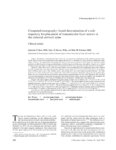 |
Bisson, Erica F. | Computed tomography-based determination of a safe trajectory for placement of transarticular facet screws in the subaxial cervical spine: Clinical article | Object. Placement of transarticular facet screws is one option for stabilization of the subaxial cervical spine. Small clinical series and biomechanical data support their role as a substitute for other posterior stabilization techniques; however, the application of transarticular facet screws in th... | | 2012-01-01 |
| 45 |
 |
Couldwell, William T. | Conflict and opportunity: neurosurgery and industry | The relationship between neurosurgery and industry is multifaceted. Most aspects of this relationship promote the advancement of a highly technical field such as neurosurgery, helping neurosurgeons bring ever more effective therapies to their patients. However, serious ethical and legal concerns a... | | 2007-01-01 |
| 46 |
 |
Couldwell, William T. | Cosmetic mastoidectomy for the combined supra/infratentorial transtemporal approach | The authors describe a cosmetic mastoidectomy technique for use when performing a combined supra/ infratentorial craniotomy and transtemporal exposure. The technique involves a single temporal suboccipital bone flap and cosmetic mastoidectomy, removing the outer table of bone for later replacement... | Surgical approach; Supratentorial approach; Infratentorial approach; Petroclival meningiomas | 1993 |
| 47 |
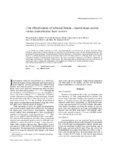 |
Bisson, Erica F. | Cost effectiveness of subaxial fusion-lateral mass screws versus transarticular facet screws | As health care reform continues to evolve, demonstrating the cost effectiveness of spinal fusion procedures will be of critical value. Posterior subaxial cervical fusion with lateral mass screw and rod instrumentation is a wellestablished fixation technique. Subaxial transarticular facet fixation is... | | 2012-01-01 |
| 48 |
 |
Kestle, John R. W. | Cost-effectiveness analysis of endoscopic third ventriculostomy | OBJECTIVE: Endoscopic third ventriculostomy (ETV) is currently the principal alternative to cerebrospinal fluid shunt placement in the management of pediatric hydrocephalus. Cost-effectiveness analysis can help determine the optimal strategy for integrating these different approaches. METHODS: All... | Endoscopic third ventriculostomy; ETV | 2002 |
| 49 |
 |
Kestle, John R. W.; Brockmeyer, Douglas Lee | Cranial base strategies for resection of craniopharyngioma in children | The optimal treatment of craniopharyngioma in children remains a challenge. The use of complete excision to minimize recurrence continues to be controversial because of the risk of postoperative morbidity and death. Advances in skull base approaches, modern microsurgical techniques, neuroimaging, an... | Craniopharyngioma; Surgical approach; Skull base surgery | 2005 |
| 50 |
 |
Couldwell, William T. | Cranioplasty with the Medpor porous polyethylene Flexblock implant | The authors describe the use of a porous polyethylene Flexblock implant for cosmetic cranioplasty. The implant may be used to cover any small- or medium-sized (< 8 cm) cranial defect, offering similar cosmetic results to standard alloplast cranioplasty while decreasing operation time. The porous i... | Cranioplasty; Medpor; Alloplast; Polyethylene; Skull defect | 1994 |
| 51 |
 |
Couldwell, William T.; House, Paul A. | De novo fenestration of the optic nerve | Fenestration of the optic nerve or chiasm due to the presence of an aneurysmal dilation of the internal carotid artery (ICA) has been described previously. In three of five cases reviewed recently, the optic nerve was penetrated by an ICA?ophthalmic artery aneurysm.3 Penetration of the optic nerve w... | Fenestration; Aneurysm | 2005 |
| 52 |
 |
House, Paul A.; Couldwell, William T. | De novo fenestration of the optic nerve case illustration. | Fenestration of the optic nerve or chiasm due to the presence of aneurismal dilation of the internal carotid artery (ICA) has been described. In three out of five cases reviewed recently, the optic nerve was penetrated by an ICAΓÇôophthalmic artery aneurysm.3 Penetration of the optic nerve was du... | Aneurysm; Congenital Optic Nerve | 2005-02-01 |
| 53 |
 |
Kestle, John R. W. | Death after late failure of third ventriculostomy in children | Late failure following successful third ventriculostomy for obstructive hydrocephalus is rare, and death caused by failure of a previously successful third ventriculostomy has been reported only once. The authors present three patients who died as a result of increased intracranial pressure (ICP) a... | Ventriculostomy; Obstructive hydrocephalus; Late failure; Death | 2002 |
| 54 |
 |
Couldwell, William T.; Apfelbaum, Ronald I. | Decompression of cavernous sinus meningioma for preservation and improvement of cranial nerve function | Meningiomas are the most common tumors affecting the cavernous sinus (CS). Despite advances in microsurgery and radiosurgery, treatment of CS meningiomas remains difficult and controversial. As in cases of other meningiomas, the goal of treatment for CS meningioma is long-term growth control and pre... | | 2006-07 |
| 55 |
 |
Couldwell, William T. | Defining postoperative values for successful resection of prolactinomas | We, as other authors, have noted that late relapse of hyperprolactinemia following apparent successful adenomectomy in women harboring microprolactinomas is not rare.[1-3] On retrospective review of a series of tumors treated at the University of Southern California teaching hospitals, we have foun... | Hyperprolactinemia; Microadenoma; Prolactin | 1996 |
| 56 |
 |
Couldwell, William T. | Definition of the role of contemporary surgical management in cisternal and parenchymatous cysticercosis cerebri | With increasing immigration from endemic regions, the incidence of neurocysticercosis in North America is rising. This retrospective study was undertaken to examine the role of surgery in those cases presenting with large cystic parenchymal and cisternal lesions in the current era of anthelminthic a... | Brain cyst; Computed tomography; Neurocysticercosis; Magnetic resonance imaging; Praziquantel; Stereotaxis | 1991 |
| 57 |
 |
Couldwell, William T. | Delayed vasospasm after removal of a skull base meningioma | Cerebral vasospasm is a well-known clinical entity associated with subarachnoid hemorrhage and traumatic brain injury [1,2]. In rare instances, vasospasm has been reported to occur after tumor resections, more specifically, after skull base tumor removal [3-5]. We report a rare case of a patient pre... | | 2012-01-01 |
| 58 |
 |
Kestle, John R. W. | Determining the best cerebrospinal fluid shunt valve design: the pediatric valve design trial | Myriad cerebrospinal fluid shunt valve designs are available (17, IS). None has ever been shown to be superior to another, although claims by neurosurgeons and shunt manufacturers of the merits of particular designs are numerous. Such is the case with two recent shunt valve designs, the Orbis-Sigm... | Pediatric valve design; Shunt valves | 1996 |
| 59 |
 |
Couldwell, William T.; Jensen, Randy L.; Jensen, Elizabeth M. | Development of contrast enhancement after long-term observation of a dysembryoplastic neuroepithelial tumor | Dysembryoplastic neuroepithelial tumors (DNET) are usually benign lesions that arise in cortical regions and are discovered after new onset of seizure. These lesions have many different imaging characteristics. We report a patient with a presumed low-grade medial temporal lobe lesion that was follow... | Brain tumor; Dysembryoplastic neuroepithelial tumors; DNET; Imaging; Seizures | 2006 |
| 60 |
 |
Couldwell, William T. | Development of neurosurgery in Southern California and the Los Angeles County/University of Southern California Medical Center | The Los Angeles County General Hospital has played an integral role in the development of medicine and neurosurgery in Southern California. From its fledgling beginnings, the University of Southern California School of Medicine has been closely affiliated with the hospital, providing the predomina... | Historical vignette; Los Angeles County General Hospital; University of Southern California School of Medicine; Neurosurgical history | 1993 |
| 61 |
 |
Couldwell, William T. | Diagnosis and management of Cushing disease | The management of a case involving Cushing disease, defined as excess secretion of adrenocorticotropic hormone (ACTH) from a pituitary adenoma, remains one of the most vexing problems facing the pituitary surgeon. The systemic consequences of this endocrinopathy are profound morbidity and premature... | | 2007-01-01 |
| 62 |
 |
Schmidt, Meic H. | Diagnosis and management of sacral Tarlov cysts | Perineurial (Tarlov) cysts are meningeal dilations of the posterior spinal nerve root sheath that most often affect sacral roots and can cause a progressive painful radiculopathy. Tarlov cysts are most commonly diagnosed by lumbosacral magnetic resonance imaging and can often be demonstrated by com... | Tarlov cysts; Meningeal dilations; Spinal lesion; Outcome | 2003 |
| 63 |
 |
Dailey, Andrew T. | Diagnosis and treatment of craniocervical dislocation in a series of 17 consecutive survivors during an 8-year period | Object. Craniocervical dissociation (CCD) is a highly unstable and usually fatal injury resulting from osseoligamentous disruption between the occiput and C-2. The purpose of this study was to elucidate systematic factors associated with delays in diagnosing and treating this life-threatening condit... | Spinal cord injury; Craniocervical dislocation; Atlantooccipital joint; Atlantoaxial joint; Tetraplegia; CCJ; CCD | 2006 |
| 64 |
 |
Dailey, Andrew T.; Brodke, Darrel S. | Differences between neurosurgeons and orthopaedic surgeons in classifying cervical dislocation injuries and making assessment and treatment decisions: a multicenter reliability study | Variability exists in the management of cervical spinal injuries. The goal of this study was to assess the effect of training specialty (orthopedic surgery vs neurosurgery) on management of cervical dislocations. | Cervical dislocation injuries; Classification; Orthopedic surgeons; Orthopaedic surgeons; Assessment decisions; Treatment decisions | 2008 |
| 65 |
 |
Schmidt, Meic H. | Diffuse large B-cell lymphoma presenting as a sacral tumor | Primary lymphomas of the sacrum are rare tumors, reported only in a few cases in the literature. The authors describe two patients with diffuse large B-cell lymphomas presenting as a sacral tumor. In the first case a 52-year-old man presented with progressive back pain, bilateral radicular pain, an... | B-cell lymphoma; Sacral tumor | 2003 |
| 66 |
 |
Couldwell, William T.; Gottfried, Oren N. | Distal ventriculoperitoneal shunt failure secondary to clostridium difficile colitis | Distal ventriculoperitoneal shunt obstruction is typically associated with cerebrospinal fluid (CSF) infection, fluid pseudocysts, bowel obstruction, bowel perforation, or improper shunt placement in the abdomen. We describe a unique etiology for distal shunt obstruction secondary to Clostridium di... | | 2005-01-01 |
| 67 |
 |
Couldwell, William T. | Distal ventriculoperitoneal shunt failure secondary to Clostridium Difficile Colitis | Distal ventriculoperitoneal shunt obstruction is typically associated with cerebrospinal fluid (CSF) infection, fluid pseudocysts, bowel obstruction, bowel perforation, or improper shunt placement in the abdomen. We describe a unique etiology for distal shunt obstruction secondary to Clostridium dif... | Shunt Failure | 2005-03 |
| 68 |
 |
Kestle, John R. W. | Does thalamotomy alter the course of Parkinson's disease? | Irving Cooper (3) observed that unilateral Parkinson's disease seemed less likely to progress to the other side of the body after thalamotomy that abolished contralateral tremor and rigidity, an effect that he felt might be the result of either the surgery itself or the slow progression of that par... | | 1996 |
| 69 |
 |
Dailey, Andrew T.; Brodke, Darrel S. | Dynamic cervical plates: biomechanical evaluation of load sharing and stiffness | Study Design. An in vitro biomechanical study using a simulated cervical corpectomy model to compare the load-sharing properties and stiffnesses of two static and two dynamic cervical plates. Objectives. To evaluate the load-sharing properties of the instrumentation with a full-length graft and... | In vitro biomechanical study; Cervical corpectomy; Cervical plates | 2001 |
| 70 |
 |
Digre, Kathleen B.; Blumenthal, Deborah T.; Salzman, Karen L.; Jensen, Randy L.; Dunson, William A. | Early pathologic findings and long-term improvement in anti-Ma2-associated encephalitis. | A 67-year-old man sequentially developed anti-Ma2-associated paraneoplastic encephalitis (PNE) and contralateral herpes simplex encephalitis (HSE). Brain biopsy 1 month before HSE revealed extensive infiltrates of T cells, B cells, and plasma cells. Most T cells expressed the cytotoxic granule-assoc... | Paraneoplastic neurologic disorders; Encephalitis; Neoplasm;Herpes Simplex | 2006-07-11 |
| 71 |
 |
Digre, Kathleen B.; Blumenthal, Deborah T.; Salzman, Karen L.; Jensen, Randy L.; Dunson, William A. | Early pathologic findings and long-term improvement in anti-Ma2-associated encephalitis. | A 67-year-old man sequentially developed anti-Ma2-associated paraneoplastic encephalitis (PNE) and contralateral herpes simplex encephalitis (HSE). Brain biopsy 1 month before HSE revealed extensive infiltrates of T cells, B cells, and plasma cells. Most T cells expressed the cytotoxic granule-assoc... | Paraneoplastic neurologic disorders; Encephalitis; Neoplasm;Herpes Simplex | 2006-07-11 |
| 72 |
 |
Couldwell, William T. | Effect of absorbable topical hemostatic agents on the relaxation time of blood: an in vitro study with implications for postoperative magnetic resonance imaging | Absorbable topical hemostatic agents are commonly used in neurosurgery. In this study the authors examine the longitudinal relaxation time (T1) of blood in contact with these agents over time, measured in vitro, to determine if their presence could affect the interpretation of postoperative magneti... | Absorbable hemostatic agent; Collastat; Surgicel; Oxidized regenerated cellulose; Methemoglobin | 2001 |
| 73 |
 |
Kestle, John R. W. | Effect of hyperventilation on regional cerebral blood flow in head-injured children | Objectives: To study cerebral blood flow and cerebral oxygen consumption in severe head-injured children and also to assess the effect of hyperventilation on regional cerebral blood flow. Design: Prospective cohort study. Setting: Pediatric intensive care unit at a tertiary-level university childre... | Cerebral blood flow; Head injury; Jugular venous oximetry; Xenon computed tomography scan; Head-injured children | 1997 |
| 74 |
 |
Kestle, John R. W. | Effect of single-application topical ophthalmic anesthesia in patients with trigeminal neuralgia: a randomized double-blind placebo-controlled trial | To evaluate the reported benefit of ipsilateral single-application ophthalmic anesthetic eyedrops in patients with typical trigeminal neuralgia, a randomized double-blind placebo-controlled trial was performed. Fortyseven patients were randomly assigned to receive two drops of either proparacaine (... | Randomized trial; Ophthalmic anesthesia | 1994 |
| 75 |
 |
Couldwell, William T. | Efficacy of clip-wrapping in treatment of complex pediatric aneurysms | Purpose: Pediatric aneurysms (PAs) are distinct from their adult counterparts with respect to typical location, aneurysm type, and known predisposing risk factors. Many strategies have been employed to treat PAs, but, although it has been used frequently in adults, clip-wrapping in pediatric patient... | | 2012-01-01 |
| 76 |
 |
Kestle, John R. W.; MacDonald, Joel D.; Couldwell, William T. | Efficacy of multiple intraarterial papaverine infusions for improvement in cerebral circulation time in patients with recurrent cerebral vasospasm | Object. Cerebral vasospasm that is caused by aneurysmal subarachnoid hemorrhage and that is refractory to maximal medical management can be treated with selective intraarterial papaverine infusions. The effects of single papaverine treatments on cerebral circulation time are well known. The purpose ... | Cerebral vasospasm; Intraarterial papaverine infusions | 2004 |
| 77 |
 |
Schmidt, Meic H. | Embolization of sacral tumors | The management of sacral tumors is challenging because of difficulties in accessing the lesion, the high rate of local recurrence, extensive vascularity causing significant intraoperative blood loss, resistance to radiation therapy, and risk of malignant transformation. Although surgery is the main ... | Sacral tumor | 2003 |
| 78 |
 |
Dailey, Andrew T. | Emergent aneurysm clipping without angiography in the moribund patient with intracerebral hemorrhage: the use of infusion computed tomography scans | THE AUTHORS REPORT their experience with 25 patients (mean age, 44.3 ± 12.1 years) with an intracerebral hematoma (ICH) from a ruptured aneurysm who were emergently operated on without angiography. Instead, preoperative high-resolution infusion computed tomography (CT) scans were used to identify... | Ruptured aneurysms; Computed tomography; Infusion computed tomography; Aneurysm clipping | 1993 |
| 79 |
 |
Couldwell, William T.; Orlandi, Richard R.; Jensen, Randy L. | Endoscopic-assisted craniofacial resection of esthesioneuroblastoma: minimizing facial incisions | The surgical management of esthesioneuroblastomas has traditionally been craniofacial resection, which combines a bifrontal craniotomy with a transfacial approach. The latter usually involves a disfiguring facial incision, mid-facial degloving, lateral rhinotomy, and/or extensive facial osteotomies... | Esthesioneuroblastoma; Craniofacial resection; Endoscope; Craniofacial surgery; Minimally invasive | 2003 |
| 80 |
 |
Couldwell, William T. | Enhanced protein kinase C activity correlates with the growth rate of malignant gliomas in vitro | Direct measurement of protein kinase C (PKC) activity in vitro revealed a significant increase in the activity of the enzyme in all human malignant glioma lines examined and the rat C6 tumor in comparison with control nonneoplastic astrocyte and mixed glial cultures. The total and particulate PKC ac... | Brain neoplasms; Flow cytometry; Glioma; Phorbol ester; Protein kinase C | 1991 |
| 81 |
 |
Kestle, John R. W.; Brockmeyer, Douglas Lee | Evaluation of the necessity of postoperative imaging after craniosynostosis surgery | Object. Childhood radiation exposure increases the lifetime risk of cancer from an estimated 0.07 to 0.35%. Neurological evaluation of patients after cranial vault reconstruction for synostosis repair is often complicated by pain medication, sedation, intubation, swelling, and dressings; therefore c... | Computed tomography; Cranial vault reconstruction; Pediatric neurosurgery; Radiation dose; Postoperative imaging | 2007 |
| 82 |
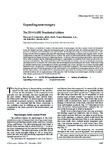 |
Couldwell, William T. | Expanding neurosurgery | The history of medicine is replete with innovations in neurosurgery that have spurred further developments across the medical spectrum. Surgeons treating pathologies in the head and spine have broken ground with new approaches, techniques, and technologies since ancient times. Neurosurgeons occupy a... | | 2014-01-01 |
| 83 |
 |
Couldwell, William T. | Experience with use of extended length peritoneal shunt catheters | The placement of a ventriculoperitoneal (VP) shunt is the current treatment of choice for diversion of cerebrospinal fluid associated with hydrocephalus. Although there are a host of reported potential abdominal complications related to the procedure, they are notably uncommon. The authors report t... | | 1996 |
| 84 |
 |
Couldwell, William T.; Chin, Steven S. | Extranodal NK/T-cell lymphoma presenting as a pituitary mass | Extranodal NK/T-cell lymphomas are uncommon neoplasms that are highly aggressive and show a strong association with Epstein-Barr virus. They most commonly affect the nasal cavity and paranasal sinuses; manifestation as a primary pituitary tumor has never been described. The authors report a case of ... | | 2007-09 |
| 85 |
 |
Couldwell, William T. | False-negative magnetic resonance angiography with extracranial internal carotid artery stenosis: a report of two cases and review of the literature | Magnetic resonance angiography (MRA) is increasingly used as a noninvasive means to assess internal carotid artery (ICA) stenosis. When used alone, however, MRA may not be sufficiently accurate in certain settings to determine whether ICA disease meets surgical criteria. Although MRA has been recogn... | Internal carotid artery stenosis; Magnetic resonance angiography | 2005 |
| 86 |
 |
Couldwell, William T. | Far Lateral Transcondylar Approach for Resection of Neurenteric Cysts of the Cervicomedullary Junction (Far-lateral transcondylar approach: surgical technique and its application in neurenteric cysts of the cervicomedullary junction. Report of two cases.) | Neurenteric cysts are rare benign lesions of the central nervous system that are lined by endodermal cell-derived epithelium. Although they occur mostly in the spine, they can occur intracranially, most often in the posterior fossa. Neurenteric cysts that are located in the anterior cervicomedullary... | Cervical Vertebrae; Medulla Oblongata; Neural Tube Defects; Neurosurgical Procedure | 2005-08-15 |
| 87 |
 |
Schmidt, Meic H.; Couldwell, William T. | Far lateral transcondylar transtubercular approach to lesions of the ventral foramen magnum and craniovertebral junction | The craniovertebral junction, which consists of the lower one third of the clivus, the foramen magnum, and the CI and C2 vertebrae, is a common site for neoplastic, vascular, congenital, and degenerative lesions of the cranial base. The far lateral transcondylar transtubercular approach (commonlyr... | Far-lateral; Transcondylar; Transtubercular; Ventral foramen magnum; Craniovertebral junction | 2007 |
| 88 |
 |
Couldwell, William T. | Far-lateral transcondylar approach: surgical technique and its application in neurenteric cysts of the cervicomedullary junction | Neurenteric cysts are rare benign lesions of the central nervous system that are lined by endodermal cell-derived epithelium. Although they occur mostly in the spine, they can occur intracranially, most often in the posterior fossa. Neurenteric cysts that are located in the anterior cervicomedullary... | | 2005 |
| 89 |
 |
Couldwell, William T. | Fenestration of the oculomotor nerve by a duplicated posterior cerebral artery and aneurysm | The authors report a case of a posterior cerebral artery aneurysm arising from an aberrant arterial branch that was found to be splitting the oculomotor nerve. This 63-year-old man presented with headaches, and CT imaging revealed subarachnoid hemorrhage primarily within the basilar cisterns. Formal... | | 2009-01-01 |
| 90 |
 |
Schmidt, Meic H. | Frameless stereotactic image-guided C1-C2 transarticular screw fixation for atlantoaxial instability: review of 20 patients | Atlantoaxial instability can result from trauma, rheumatoid arthritis, congenital malformation, or tumor invasion. The goal of treatment is stabilization of the C1-C2 complex to prevent neurologic and neurovascular compromise. First described in 1987 by Magerl and Seemann, C1-C2 transarticular screw... | Transarticular screws; Atlantoaxial instability; Frameless stereotaxy; Cervical spine; Surgical navigation; Trajectory planning | 2005 |
| 91 |
 |
Couldwell, William T. | The frontotemporal (Pterional) approach: an historical perspective | The frontotemporal, so-called "pterional" approach has evolved with the contribution of many neurosurgeons over the past century. It has stood the test of time and been the most commonly used transcranial approach in neurosurgery. In its current form, drilling the sphenoid wing as far down as the su... | | 2012-01-01 |
| 92 |
 |
Couldwell, William T. | Ganglion cyst of the temporomandibular joint with intracranial extension in a patient presenting with seventh cranial nerve palsy | Ganglion cysts arising from the temporomandibular joint are rare entities that often present with swelling and minimal to no pain in the preauricular region. To the Author's? knowledge, a temporomandibular joint ganglion cyst occurring with acute facial nerve palsy and intracranial extension has ne... | | 2012 |
| 93 |
 |
Couldwell, William T. | Giant fusiform aneurysm in an adolescent with PHACES syndrome treated with a high-flow external carotid artery-M3 bypass | The acronym PHACES describes a rare neurocutaneous syndrome that comprises posterior fossa malformations, facial hemangiomas, arterial anomalies, coarctation of the aorta and cardiac defects, eye abnormalities, and sternal defects. Facial hemangiomas constitute the hallmark of this disorder. Giant ... | | 2007 |
| 94 |
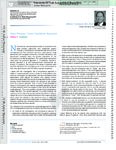 |
Couldwell, William T. | Giant pituitary tumor combined approach | Nishioka et al. have provided a review of 29 patients with large pituitary adenomas who underwent surgery through a simultaneous transsphenoidal and transcranial approach at their institution during a 7-year period. Large adenomas with hourglass constriction, complex lobulations, and asymmetric exte... | | 2012-01-01 |
| 95 |
 |
Couldwell, William T.; Schmidt, Richard H.; Salzman, Karen L.; Chin, Steven S. | Glioblastoma multiforme of the pineal region | Glioblastoma multiforme (GBMs) tumors are exceedingly rare tumors in the pineal region. We present three cases in which patients presented with a pineal/posterior third ventricular region mass and review all the previously reported cases in the literature. Pineal region GBM seems to be a very aggre... | Glioblastoma multiforme; Hydrocephalus; Leptomeningeal dissemination; Malignant glioma; Perinaud's syndrome; Pineal region; Spinal metastases | 2006 |
| 96 |
 |
Couldwell, William T. | Glioma invasion | A characteristic pathological feature of malignant glioma cells is their ability to extensively invade surrounding brain parenchyma-particularly along white matter tracts- thus rendering focal therapies incapable of controlling tumor growth and resulting in inevitable recurrence. In this regard, ... | | 2001 |
| 97 |
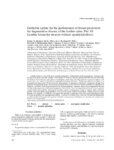 |
Dailey, Andrew T. | Guideline update for the performance of fusion procedures for degenerative disease of the lumbar spine. Part 10: Lumbar fusion for stenosis without spondylolisthesis | Lumbar stenosis is one of the more common radiographic manifestations of the aging process, leading to narrowing of the spinal canal and foramen. When stenosis is clinically relevant, patients often describe activity-related low-back or lower-extremity pain, known as neurogenic claudication. For tho... | | 2014-01-01 |
| 98 |
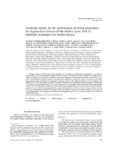 |
Dailey, Andrew T. | Guideline update for the performance of fusion procedures for degenerative disease of the lumbar spine. Part 11: Interbody techniques for lumbar fusion | Interbody fusion techniques have been promoted as an adjunct to lumbar fusion procedures in an effort to enhance fusion rates and potentially improve clinical outcome. The medical evidence continues to suggest that interbody techniques are associated with higher fusion rates compared with posterolat... | | 2014-01-01 |
| 99 |
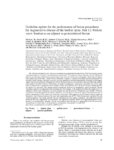 |
Dailey, Andrew T. | Guideline update for the performance of fusion procedures for degenerative disease of the lumbar spine. Part 12: Pedicle screw fixation as an adjunct to posterolateral fusion | The utilization of pedicle screw fixation as an adjunct to posterolateral lumbar fusion (PLF) has become routine, but demonstration of a definitive benefit remains problematic. The medical evidence indicates that the addition of pedicle screw fixation to PLF increases fusion rates when assessed with... | | 2014-01-01 |
| 100 |
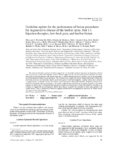 |
Dailey, Andrew T. | Guideline update for the performance of fusion procedures for degenerative disease of the lumbar spine. Part 13: Injection therapies, low-back pain, and lumbar fusion | The medical literature continues to fail to support the use of lumbar epidural injections for long-term relief of chronic back pain without radiculopathy. There is limited support for the use of lumbar epidural injections for short-term relief in selected patients with chronic back pain. Lumbar intr... | | 2014-01-01 |




































































































